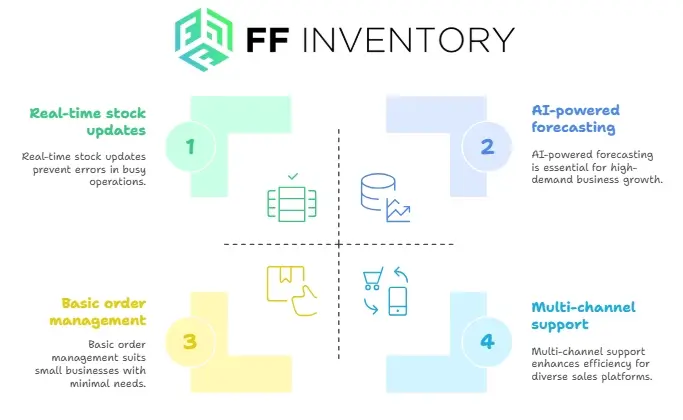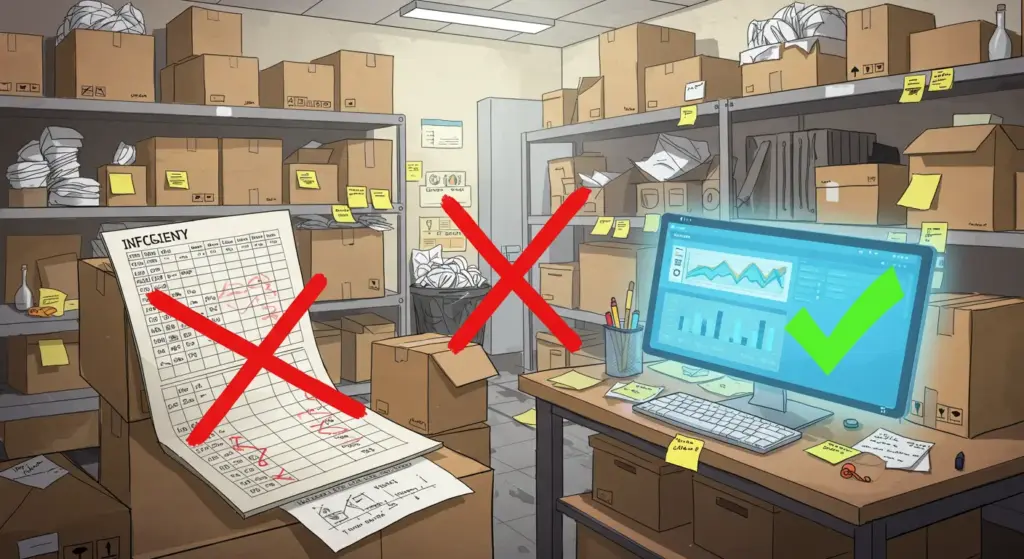Mastering Inventory Management for Small Businesses: A Practical Guide

Ever felt like keeping track of your stock is more of a guessing game than a strategy? You’re not alone. Inventory management can be overwhelming, especially for small businesses juggling multiple sales channels, suppliers, and warehouses. With FF Inventory, smart stock control is finally within reach.
The problem? Stockouts lead to lost sales, overstock ties up cash, and manual tracking is a nightmare. But with the right inventory management system for small business, you can take control, cut costs, and scale smoothly.
This guide breaks it down—no fluff, no jargon—just clear, actionable insights on how to track stock levels, manage purchase orders, and prevent costly mistakes. Whether you’re handling e-commerce inventory, warehouse stock, or retail goods, we’ve got you covered.
Let’s make inventory tracking effortless.
Why Inventory Management Matters for Small Businesses

Running a small business comes with enough challenges—inventory management shouldn’t be one of them. Whether you’re tracking stock across multiple locations, managing purchase orders, or trying to prevent stockouts, having the right inventory system can make all the difference.
Without proper inventory control, businesses often face:
❌ Overselling – Running out of stock and disappointing customers.
❌ Overstocking – Wasting cash on excess inventory that sits unsold.
❌ Manual Errors – Lost products, inaccurate stock counts, and fulfillment delays.
A good inventory management system for small business owners keeps everything running smoothly. It ensures that stock levels update in real-time, purchase orders are organized, and every sale is accounted for.
In the next section, we’ll break down how to streamline inventory control and choose the best system for your needs.
How to Choose the Right Inventory Management System for Your Business

Now that you know the key components of effective inventory management, the next step is choosing a system that fits your business. Not all inventory software is built the same—some are too complex, others too basic. So, how do you find the right balance?
Here’s what to consider:
1. Does It Fit Your Business Size?
A small business inventory management system should be scalable—starting simple but offering room for growth. If you run a warehouse, an online store, or multiple locations, you need software that grows with you.
2. Real-Time Stock Updates & Automation
Manual tracking leads to mistakes. Choose a system that automatically updates stock levels when an order is placed, a return is processed, or a purchase order is received.
3. Easy Order Management
An inventory system should let you create, track, and manage purchase orders and sales orders seamlessly. Look for features like multi-supplier tracking and automated reordering.
4. Multi-Channel & Warehouse Support
If you sell on Shopify, Amazon, or manage stock across multiple locations, your inventory system should sync everything in one place to avoid overselling or miscounts.
5. Forecasting & Analytics for Smarter Decisions
While FF Inventory 2.0 will soon introduce AI-powered inventory forecasting, even basic reports on sales trends, stock movements, and demand predictions can help prevent stock issues and optimize purchasing.
Best Practices for Managing Inventory Efficiently

Now that you know how to choose the right inventory management system, the next step is optimizing how you manage inventory daily. Even with the best software, poor inventory habits can still lead to stockouts, wasted cash, and fulfillment delays.
Here are five proven strategies to keep your stock under control:
1. Set Minimum and Maximum Stock Levels
Not every product needs to be reordered at the same rate. Set a minimum stock level to trigger reorders before running out and a maximum level to prevent overstocking. This ensures you always have what you need—without wasting money on excess stock.
2. Conduct Regular Inventory Audits
Even with real-time inventory tracking, physical stock checks help catch discrepancies. Businesses should do:
✔ Cycle counts – Small, frequent stock checks to ensure accuracy.
✔ Full inventory audits – Complete stock verification at least once a year.
3. Use Batch and Serial Number Tracking for Better Accuracy
For businesses dealing with perishable goods, electronics, or regulated products, batch and serial number tracking is essential. It ensures:
✔ Easy product recalls when necessary.
✔ Proper stock rotation to minimize waste.
✔ Better tracking of product history.
4. Automate Purchase Orders & Reordering
Manually placing orders is time-consuming and prone to errors. Instead, use an inventory management system for small businesses that:
✔ Automatically generates purchase orders when stock levels hit minimum thresholds.
✔ Sends supplier requests directly to streamline restocking.
5. Leverage Sales & Demand Forecasting
Stocking up on the wrong products can tie up cash flow. While AI-powered inventory forecasting (coming soon to FF Inventory) can predict demand, businesses can also:
✔ Analyze past sales trends to adjust stock levels.
✔ Monitor seasonal demand shifts to prepare in advance.
✔ Use historical data to negotiate better deals with suppliers.
Common Inventory Management Mistakes & How to Avoid Them

Even with a solid inventory management system, businesses can still run into stock issues that hurt cash flow and customer satisfaction. Here are some of the biggest inventory mistakes—and how to fix them.
1. Relying on Manual Stock Tracking
- The Problem: Using spreadsheets or paper-based systems leads to errors, lost data, and inaccurate stock counts.
- The Fix: Invest in an inventory management system for small businesses that automatically updates stock levels in real-time and syncs across multiple locations.
2. Poor Demand Planning
- The Problem: Overstocking ties up cash, while understocking leads to lost sales.
- The Fix: Use historical sales data and seasonal trends to forecast demand. FF Inventory 2.0 will soon include AI-powered inventory forecasting to help businesses predict stock needs with greater accuracy.
3. Ignoring Batch & Serial Tracking
- The Problem: Without batch number tracking, businesses struggle to track product lifecycles, recalls, or warranty claims.
- The Fix: Enable batch tracking and serial number tracking to monitor stock movement, expiration dates, and compliance requirements.
4. Not Managing Purchase Orders Efficiently
- The Problem: Placing last-minute orders or failing to track supplier deliveries can lead to stock shortages.
- The Fix: Automate purchase order management with a system that sets reorder points and tracks supplier performance to prevent delays.
5. Lack of Multi-Location Stock Control
- The Problem: Businesses operating in multiple locations often deal with inconsistent stock levels, miscommunication, and order fulfillment delays.
- The Fix: Use an inventory system that syncs inventory across warehouses, retail locations, and online stores in real-time.
How FF Inventory 2.0 Solves These Challenges

After covering the biggest inventory management mistakes, let’s talk about how FF Inventory 2.0 eliminates these issues and makes stock management effortless.
1. Real-Time Stock Tracking (No More Manual Errors)
How FF Inventory Helps:
- Automatically updates stock levels as orders are placed or shipments arrive.
- Syncs inventory across multiple locations so you always have accurate stock counts.
- Prevents overselling by ensuring real-time visibility into available stock.
2. Smarter Forecasting to Avoid Overstocking & Stockouts
How FF Inventory Helps:
- Uses historical sales data and seasonal trends to predict demand.
- Helps businesses order the right amount of stock at the right time.
- (Coming Soon!) AI-powered inventory forecasting for even more accurate stock planning.
3. Built-In Batch & Serial Number Tracking
How FF Inventory Helps:
- Tracks batch numbers and serial numbers to ensure product traceability.
- Simplifies product recalls, expiration tracking, and compliance management.
- Improves warranty tracking for serialized products.
Want to know more about our journey and values? Check out About FF Inventory to see how we’re transforming stock control for small businesses.
4. Automated Purchase Order Management
How FF Inventory Helps:
- Automatically generates purchase orders when stock levels hit reorder points.
- Tracks supplier deliveries and order status in real-time.
- Centralizes supplier data to avoid last-minute stock shortages.
5. Multi-Location Inventory Control & E-Commerce Integration
How FF Inventory Helps:
- Manages stock across multiple warehouses, retail stores, and fulfillment centers.
- Syncs inventory with e-commerce platforms like Shopify, WooCommerce, and marketplaces like Amazon.
- Reduces order fulfillment delays by ensuring stock accuracy across locations.
Explore the full range of features and tools on our FF Inventory services page.
Take Control of Your Inventory with FF Inventory 2.0
No more guesswork, no more stock issues—just smart, scalable inventory management that grows with your business.
FF Inventory 2.0 is launching soon! Be the first to experience a simpler, more powerful way to manage inventory.
